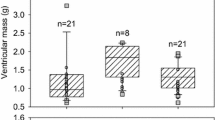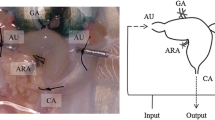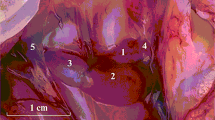Summary
-
1.
Catabolic processes of the phasic and catch parts of the adductor muscle ofPlacopecten magellanicus have been studied in relation to valve snap and valve closure responses. It is concluded that the snap response is powered by both parts of the adductor muscle and the valve closure response is powered exclusively by the catch part.
-
2.
Both parts of the adductor muscle show a high glycolytic potential, reflected by high levels of glycolytic enzymes (Table 1) and high glycogen levels (Table 2). Lactate dehydrogenase could not be detected. In contrast, octopine dehydrogenase shows high activities in both parts of the adductor muscle. It is therefore concluded that a main anaerobic pathway in both tissues is the breakdown of glycogen to octopine. In the catch part, however, a considerable amount of the pyruvate formed from glycogen may also be converted into alanine (see below). The glycolytic flux in the catch part is much higher during the snap response than during valve closure.
-
3.
The absence of phosphoenolpyruvate carboxykinase in the adductor muscle ofP. magellanicus and the observed changes in aspartate, alanine and succinate demonstrate that the energy metabolism in the catch part during valve closure shows great similarities to that which occurs only in the initial stage of anaerobiosis in the catch adductor muscle of the sea musselMytilus edulis L.
-
4.
Arginine kinase activity and arginine phosphate content of the phasic part are much higher than those of the catch part (Tables 1 and 3). This may explain why in the phasic part during the snap response most ATP equivalents are derived from arginine phosphate, and in the catch part during both valve responses most are derived from glycolysis (Table 6). Despite the limited contribution of glycolysis in the phasic part during the snap response, the glycolytic flux increases by a factor of at least 75.
-
5.
Evidence is obtained that octopine is neither transported from one part of the adductor muscle to the other, nor from the adductor muscle to other tissues.
Similar content being viewed by others
Abbreviations
- GAPDH :
-
glyceraldehyde-phosphate dehydrogenase
- αGDH :
-
glycerol-3-phosphate dehydrogenase
- LDH :
-
lactate dehydrogenase
- MDH :
-
malate dehydrogenase
- NCEA :
-
N-(1-carboxyethyl)-alanine
- NCEADH :
-
NCEA dehydrogenase
- ODH :
-
octopine dehydrogenase
- PEPCK :
-
phosphoenolpyruvate carboxykinase
- PFK :
-
phosphofructokinase
References
Baldwin, J., Lee, A.K.: Contributions of aerobic and anaerobic energy production during swimming in the bivalve molluscLimaria fragilis (family Limidae). J. Comp. Physiol.129, 361–364 (1979)
Baldwin, J., Opie, A.M.: On the role of octopine dehydrogenase in the adductor muscles of bivalve molluscs. Comp. Biochem. Physiol.61B, 85–92 (1978)
Crabtree, B., Newsholme, E.A.: The activities of phosphorylase, hexokinase, phosphofructokinase, lactate dehydrogenase and the glycerol-3-phosphate dehydrogenase in muscles from vertebrates and invertebrates. Biochem. J.126, 49–58 (1972)
Crabtree, B., Newsholme, E.A.: Comparative aspects of fuel utilization and metabolism by muscle. In: Insect muscle. Usherwood, P.R.N. (ed.), pp. 418–494. New York: Academic Press 1975
Dubois, M., Gilles, K.A., Hamilton, J.K., Rebers, P.A., Smith, F.: Colorimetric method for the determination of sugars and related substances. Anal. Chem.28, 350–356 (1956)
Ebberink, R.H.M., Zurburg, W., Zandee, D.I.: On the energy demand of the posterior adductor muscle ofMytilus edulis in catch during exposure to air. Mar. Biol. Lett. (in press)
Fields, J.H.A.: A dehydrogenase requiring alanine and pyruvate as substrates from the oyster adductor muscle. Fed. Proc.37, 1687 (1976)
Gäde, G., Weeda, E., Gabbott, P.A.: Changes in the level of octopine during the escape responses of the scallop,Pecten maximus (L.). J. Comp. Physiol.124, 121–127 (1978)
Grieshaber, M.: An enzymatic method for the estimation of octopine. Anal. Biochem.74, 600–603 (1976)
Grieshaber, M.: Breakdown and formation of high-energy phosphates and octopine in the adductor muscle of the scallop,Chlamys opercularis (L.), during escape swimming and recovery. J. Comp. Physiol.126, 269–276 (1978)
Grieshaber, M., Gäde, G.: Energy supply and the formation of octopine in the adductor muscle of the scallopPecten jacobaeus. Comp. Biochem. Physiol.58B, 249–252 (1977)
Gutmann, I., Wahlefeld, A.W.: L-(−)-malate. Determination with malate dehydrogenase and NAD. In: Methods of enzymatic analysis. Bergmeyer, H.U. (ed.), pp. 1585–1589. New York, London: Academic Press 1974
Jaworek, D., Gruber, W., Bergmeyer, H.U.: Adenosine-5′-triphosphate. In: Methods of enzymatic analysis. Bergmeyer, H.U. (ed.), pp. 2097–2101. New York, London: Academic Press 1974a
Jaworek, D., Gruber, W., Bergmeyer, H.U.: Adenosine-5′-diphosphate and adenosine-5′-monophosphate. In: Methods of enzymatic analysis. Bergmeyer, H.U. (ed.), pp. 2127–2131. New York, London: Academic Press 1974b
Kmetec, E.: Spectrophotometric method for the enzymatic microdetermination of succinic acid. Anal. Biochem.16, 474–480 (1966)
Lamprecht, W., Stein, P., Heinz, F., Weisser, H.: Creatine phosphate. In: Methods of enzymatic analysis. Bergmeyer, H.U. (ed.), pp. 1777–1781. New York, London: Academic Press 1974
Mattison, A.G.M., Beechey, R.B.: Some studies on cellular fraction of the adductor muscle ofPecten maximus. Exp. Cell. Res.41, 227–243 (1966)
O'Doherty, P.J.A., Feltham, L.A.W.: Glycolysis and gluconeogenesis in the giant scallopPlacopecten magellanicus (Gmelin). Comp. Biochem. Physiol.38 B, 543–551 (1971)
Tappel, A.L.: Cytochromes of muscles of marine invertebrates. J. Bull. Comp. Physiol.55, 111–126 (1960)
Thompson, R.J.: Blood chemistry, biochemical composition, and the annual reproductive cycle in the giant scallop,Placopecten magellanicus, from southeast Newfoundland. J. Fish. Res. Bd. Can.34, 2104–2116 (1977)
Thompson, R.J., Bayne, B.L.: Some relationships between growth, metabolism and food in the musselMytilus edulis. Mar. Biol.27, 317–326 (1974)
Thompson, R.J., Livingstone, D.R., Zwaan, A. de: Physiological and biochemical aspects of the valve snap and valve closure responses in the giant scallopPlacopecten magellanicus. I. Physiology. J. Comp. Physiol.137, 97–104 (1980)
Vázquez-Baanante, I., Rosell-Pérez, M.: In vitro studies ofPecten maximus glycogen phosphorylase and the interconversion of their forms. Comp. Biochem. Physiol.62 B, 381–387 (1979)
Zwaan, A. de, Zandee, D.I.: Body distribution and seasonal changes in the glycogen content of the common sea musselMytilus edulis. Comp. Biochem. Physiol.43 A, 53–58 (1972)
Author information
Authors and Affiliations
Rights and permissions
About this article
Cite this article
de Zwaan, A., Thompson, R.J. & Livingstone, D.R. Physiological and biochemical aspects of the valve snap and valve closure responses in the giant scallopPlacopecten magellanicus . J Comp Physiol B 137, 105–114 (1980). https://doi.org/10.1007/BF00689208
Accepted:
Issue Date:
DOI: https://doi.org/10.1007/BF00689208




